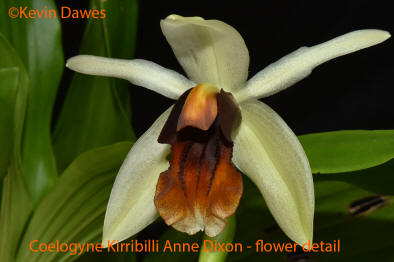Coelogyne Kirribilli Anne Dixon was officially registered with the Royal Horticultural Society in December 2016 as a primary hybrid by cross-fertilising the rare species orchid Coelogyne eberhardtii with a species orchid Coelogyne usitana. This latter orchid is very new to growers and was only officially described and registered by botanists in 2002. A primary hybrid is one made by cross-fertilising two species plants. It will therefore contain the genes of only two parent plants.
This hybrid was started when I pollinated the plants on the 16.06.2010. The resulting pods of seeds were harvested and sown under sterile laboratory conditions on 20.05.2011 when the seeds were eleven months old. After germinating, the seeds were transplanted a number of times into new flasks of agar jelly under a sterile laboratory environment until they were big enough to remove to the outside world on 28.01.2012. One plant flowered for the first time on 17.12.2016 after around four more years - a total of six and a half years.
Coelogyne usitana gained instant worldwide recognition because of its very dark lip, throat and column colourings framed by whitish/green sepals and petals. In this hybrid, these traits have carried through very strongly. The lip is a lighter, more tobacco colour and the sepals and petals are a very pale green, - a trait often evident in both parents.
The flower faces downwards like its father but Coelogyne eberhardtii, which has a very upright, open flowering habit has managed to at least produce a semi-erect flower stem that lifts the flowers substantially and most notably produced a remarkably open flower. This openness trait could be very worth noting by future breeders!
Apart from the lighter colouring on the lip and throat of the flower, Coelogyne eberhardtii has enhanced the attractiveness of the flower by leaving clearly defined, prominent keels and also large crenations on the margin of the lip.
The synanthous flower spikes have produced only two flowers per spike at this stage. These slow opening flowers are sequential and it is too early yet to tell how many flowers will develop on a spike over time. One spike on Coelogyne usitana commonly produces more than a dozen long lasting flowers over a period of many months.
Negatives: .This flower has a very downward facing aspect so typical of the group from which the pollen parent comes. This requires that the plant be grown in a hanging basket at some height or on a higher shelf so that the flower can be admired fully from below.
This is an orchid that requires a humid, shady and frost free environment. It grows very happily in a very well aerated medium such as large coco chips frequently watered.
Rating: ♦♦♦♦ This is a strong robust plant that holds the flowers well above the rim of the pot - unlike the totally pendulous nature of Coelogyne usitana. The dark colourings are extremely attractive and this hybrid could form a valuable stock for further breeding. The strong influence of Coelogyne usitana on its offspring produces a very identifiable colouring trait throughout. Time will tell if this trait becomes overworked but it certainly has huge potential.
Registration: Registration with the RHS as Coelogyne Kirribilli Anne Dixon was recorded in December 2016 (Kevin Dawes). This hybrid has been named in honour of my mother-in-law, a devoted and talented gardener responsible for my family's unending garden and landscape delights, pleasures and memories. The majority of our early garden plants (including orchids) originated from cuttings lovingly started in her garden.
Varieties: None known.
Hybrids: None registered
| < Coel Intermedia | Coel Kirribilli Carmel > |

